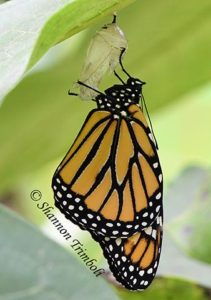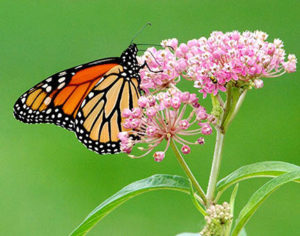On December 15, 2020, the U.S. Fish and Wildlife Service (USFWS) “found that adding the monarch butterfly to the list of threatened and endangered species is warranted but precluded by work on higher-priority listing actions.” But, what does that really mean? And how does it affect things going forward?
What does the ruling mean?
To answer that question, we need to break the finding down into its two main parts. Let’s start with the part saying that the monarch butterfly’s inclusion in the list is warranted. That part of the statement means exactly what it sounds like it is saying. Based on all the scientific research available, the monarch butterfly meets the criteria needed to be included on the endangered species list as either threatened or endangered.

The second part of the statement is the part that can raise eyebrows because it says “but precluded by work on higher-priority listing actions.” Basically, what this means is that although the monarch butterfly meets the qualifications, there are other species that are at higher risk and need to be added first. In response to that, some people might say, “But, if it meets the qualifications then it needs to be listed and protected NOW! Is the USFWS really going to just sit back and do nothing?” That’s a reasonable question that has a very practical and logical answer.
Once a species is officially included on the endangered species list, money and other resources have to be dedicated to its preservation. The USFWS, like any agency, or any individual for that matter, has a limited budget and limited resources. Some agencies or individuals may have bigger budgets and some may have smaller ones, but no one has truly unlimited resources. Those limited resources mean that the endangered species list can’t grow indefinitely, because there are only so many resources to go around and giving an inadequate amount to everyone doesn’t help anyone.
Putting it into perspective
Look at it this way. Imagine the transmission on your car just went out, the bottom of your hot water heater just rusted through, the furnace in your house just quit working, your roof started leaking, you got laid off from your job, you broke your leg, the compressor on your refrigerator stopped working, you just found out that you’ve been the victim of identity theft so all your credit cards are frozen, and, and, and… I don’t care how big your rainy day fund is, odds are that you aren’t going to be able to fix everything at once after a string of bad luck like that. You are going to have to make some tough choices and prioritize where you spend your money and what you fix first.
That’s basically what the USFWS is having to do with the monarch butterfly and other species on the “warranted but precluded” list. No one is saying that these species aren’t important or don’t need to be taken care of, but they just aren’t at the top of the priority list – yet. (Is getting the transmission on your car fixed as high of a priority as fixing your furnace in the middle of winter if you are laid off and thus won’t be driving to work every day? Yes, getting your transmission fixed is important, but the question is when you fix it not if you fix it.)
So, how does this affect things going forward?
What the “warranted but precluded” finding means is that the monarch butterfly is basically on a waiting list. (The official term for these species are candidate species.) Every year, the monarch butterfly’s status will be re-evaluated to determine if its position on that waiting list needs to change. Based on the best currently available information and models, the USFWS has tentatively proposed that the monarch butterfly be added to the endangered species list in 2024.
However, that 2024 listing date could be moved up if the monarch butterfly’s condition takes a drastic turn for the worse, or moved back if the population drastically improves. Going back to our individual analogy, if you aren’t working then fixing the transmission on your car may not be at the top of your priority list. However, if you get a new job that can’t be done remotely, then fixing your transmission sooner rather than later becomes more important. As conditions change, so do our priorities – for individuals as well as agencies.
Understandably, being on the waiting list for something like the endangered species list can sound like a really bad thing. After all, the species wouldn’t be on the waiting list if it wasn’t considered at risk of going extinct. In fact, some species have gone extinct while on the waiting list, so concerns about any species being put on the waiting list are legitimate. However, the monarch butterfly has two things going for it that many other candidate species don’t have – it is a popular species and we don’t have to rely solely on the USFWS to address the threats.
Taking a look at the threats
According to the USFWS, the major threats to the continued survival of the monarch butterfly are habitat loss, climate change, and pesticide exposure. Climate change is a common thread for many endangered and threatened species. So, working to slow climate change for any of them is going to help all of them. Plus, there is very little that the USFWS can do to directly reduce climate change at the level that will be needed to benefit most species on the endangered species list – those decisions and legislation must come from a higher administrative authority working at a global level. Along the same lines, the USFWS doesn’t make or enforce any legislation or regulations related to pesticides. So with pesticide exposure, like climate change, the USFWS can only have limited direct impacts.

Of the identified major threats to monarch butterflies, reducing habitat loss is where the USFWS can have the most direct impacts. That is also where we as individuals and as a society can have the biggest impacts and is why the monarch butterfly’s condition is so hopeful. The monarch butterfly isn’t like some of the other candidate species, or even many of the species already on the endangered species list. The monarch butterfly’s habitat needs aren’t restricted to very precise or remote locations. All it needs, at least within its breeding range, is milkweed for the caterpillars and a continuous supply of nectar providing flowers for the adults.
Bright spots and opportunities
Remember our analogy of you having a string of ridiculously horrible luck? Now imagine a friend or relative hears about it and wants to help. That friend or relative knows they can’t fix everything, but they can do something, and they are sure that others will want to help too. So, that person sets up a Go Fund Me campaign, opens a donation account at the local bank, passes the hat at church or a community gathering, or does something similar so that lots of people can contribute whatever little bits they can to help out.
Essentially, we’re contributing to the equivalent of a Go Fund Me campaign or donation account for monarch butterflies when we plant pollinator gardens that include native milkweeds as well as nectaring plants that bloom throughout the growing season. No single person or organization can fix the problem, but together we can make a big dent in the problem if lots of us contribute a little bit.
In fact, models have shown that homeowners, schools, private business, and other community organizations have the potential to provide a very significant portion of the habitat needed by monarch butterflies. The USFWS even talked about the importance of these ongoing private contributions to provide valuable monarch habitat in its finding on the monarch’s status. You could even say that the USFWS helped to put out the word, if not set up, our habitat equivalent of a Go Fund Me campaign or donation account for the monarch.
What now?
As I see it, we have two choices. First, we sit back, do nothing, and wait for the monarch to be included on the endangered species list in 2024. Or we choose the second option, and step up to do what we can to provide monarch habitat in our own yards and communities. Realistically, I can’t do anything to help a species of freshwater mussel that only occurs in a single stream system in another state or to help an endangered species of cave beetle. But I can plant milkweeds and other nectar producing species to provide habitat for monarch butterflies.
Granted, what I can do on my own property may not seem like much in the grand scheme of things. However, just like with that Go Fund Me campaign or donation account, my little bit added to other people’s little bits can add up to something huge. So, for me, “what now?” means continuing to plant more milkweeds and other nectar producing flowers. Not only will those actions benefit the monarch butterfly, but also countless other species of butterflies, bees, songbirds, and other critters.

Backyard Ecology: Exploring Nature in Your Backyard
Nature isn’t just “out there.” It’s all around us, including right outside our doors. Hi, my name is Shannon Trimboli, and I am the host of Backyard Ecology. I live in southcentral Kentucky and am a wildlife biologist, educator, author, beekeeper, and owner of a nursery specializing in plants for pollinators and wildlife conservation. I invite you to join me as we ignite our curiosity and natural wonder, explore our yards and communities, and improve our local pollinator and wildlife habitat. Learn more or subscribe to my email list at www.backyardecology.net.

Leave a Reply to Ginny Delaney Cancel reply